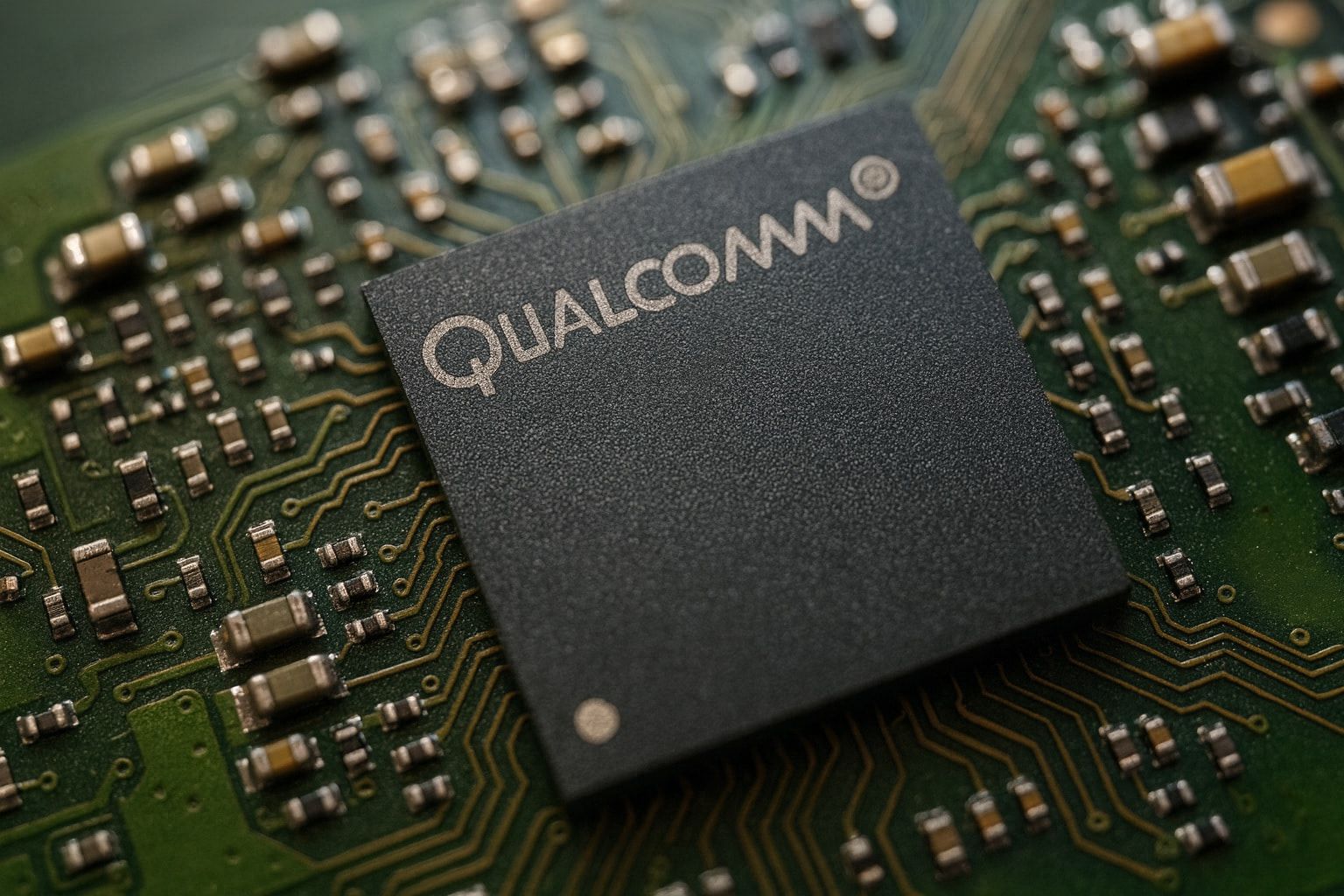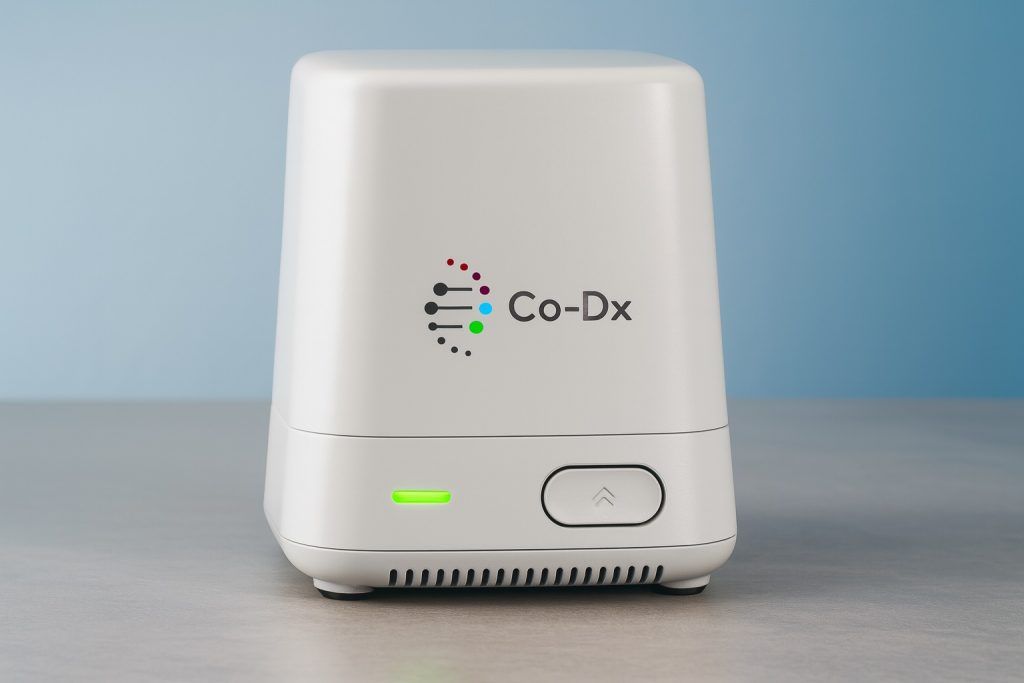- Big stock jump: Qualcomm (NASDAQ: QCOM) stock surged over 10% to a 15-month high (~$188) after the company unveiled new artificial intelligence chips designed to challenge Nvidia in data centers [1] [2]. Shares briefly spiked nearly 20% intraday before paring gains to close about 11% higher on October 27 [3].
- AI bet fuels optimism: The San Diego-based chipmaker’s foray into AI hardware – launching its AI200 and AI250 data-center chips for 2026–27 – electrified investors hoping Qualcomm can expand beyond smartphones [4]. The company’s stock hit its highest level in over a year on the news [5], reflecting confidence that Qualcomm can be a credible alternative to Nvidia and AMD for cost-efficient AI computing.
- Analysts raising targets: Wall Street is growing more bullish on Qualcomm. The consensus rating is “Moderate Buy” with an average 12-month price target around $182–$183 [6] (~8–12% above recent levels). Several firms have hiked their targets to $200 after Qualcomm’s AI push, citing new growth drivers in 5G, AI and automotive chips [7]. Some bullish analysts even see room for QCOM to approach its 2024 highs if its diversification plays out.
- Expert commentary: “Qualcomm’s entry and major deal in Saudi Arabia prove the ecosystem is fragmenting because no single company can meet the global, decentralized need for high-efficiency AI compute,” noted Joe Tigay, portfolio manager at Rational Equity Armor, after a Saudi AI startup agreed to deploy Qualcomm’s new chips [8]. The move into AI accelerators opens a potentially huge new market for Qualcomm as cloud providers invest billions in AI infrastructure.
- Broader tech context: The 2025 tech boom around generative AI has lifted many semiconductor stocks, but risks remain. Last week, Texas Instruments’ weak demand forecast sent chip shares tumbling [9], a reminder of cyclical headwinds. Qualcomm also faces fierce competition (Nvidia in AI servers, MediaTek in mobile) and potential challenges like Apple’s plan to use in-house 5G modems by 2026–2027 [10], which could eventually dent Qualcomm’s mobile chip revenues.
New AI Chips Ignite Rally in QCOM Shares
Qualcomm’s headquarters in San Diego. The chipmaker’s stock just surged on news of its expansion into data-center AI processors.
Qualcomm’s stock rallied dramatically to start the week after the company revealed a bold expansion into artificial intelligence semiconductors. On Monday (Oct. 27), the firm unveiled two AI accelerator chips – dubbed the AI200 and AI250 – aimed at powering AI in cloud data centers. This surprise announcement, part of Qualcomm’s efforts to diversify beyond a stagnant smartphone market, sent QCOM shares soaring to their highest price in 15 months [11]. Investors piled in, driving the stock up as much as 20% intraday and lifting the price into the high-$180s. Qualcomm closed the day up about 11% at roughly $187–$188 per share [12], easily the biggest one-day gain for the stock in years. The surge made Qualcomm one of the top performers on the Nasdaq and S&P 500 that day, signaling renewed market enthusiasm for the company’s direction.
The catalyst was Qualcomm’s entry into the booming AI chip arena, where Nvidia currently dominates. The company’s new AI200/AI250 chips (set for commercial release in 2026 and 2027) are designed for AI “inference” – essentially, running trained AI models in real time – and will be offered not just as chips but in complete accelerator cards and even full server racks [13] [14]. Qualcomm is touting these processors as energy-efficient, cost-effective alternatives for companies scaling up AI workloads. “These innovative new AI infrastructure solutions empower customers to deploy generative AI at unprecedented TCO (total cost of ownership), while maintaining the flexibility and security modern data centers demand,” said Qualcomm SVP Durga Malladi in a press statement [15]. In other words, Qualcomm is pitching a cheaper, more power-efficient way to handle AI tasks – an attractive proposition for cloud giants and enterprises looking to rein in the high costs of AI computing.
Investor reaction was immediate. Qualcomm’s market capitalization leapt by roughly $20 billion in a single day on the AI chip news. The stock, which had been trading around $168 last week, shot up into the $180s and at one point briefly cleared $200 during Monday’s frenzy [16]. It finished around $187, marking a new 52-week high for the shares [17]. This rally brought Qualcomm stock roughly flat for 2025 year-to-date, a notable recovery from its midsummer lows. Executives and analysts framed the jump as a vote of confidence: Qualcomm is showing it can reinvent itself, extending its reach from mobile phones into lucrative new markets. “The company is now firing on multiple cylinders,” one analyst told Reuters, pointing out that Qualcomm is leveraging its expertise in efficient chips across 5G, automotive, IoT and now cloud AI all at once [18] [19]. The strong stock response suggests investors see significant upside if these bets pay off.
Analysts Upbeat on Future Prospects
Qualcomm’s dramatic move has prompted a flurry of positive commentary from market experts. Wall Street analysts, in particular, have been raising their outlooks in light of the company’s expanding growth drivers. The stock is widely covered by around two dozen analysts, and the consensus rating remains a “Moderate Buy,” reflecting cautious optimism. Going into this week, the average 12-month price target for QCOM was about $182–183 per share [20]. That figure implied modest upside – and tellingly, Qualcomm’s big rally on Monday nearly closed that gap in a single session. In response, several firms have updated their models: Susquehanna and JPMorgan, for example, bumped their targets up to $200 and reiterated bullish ratings after the AI chip news [21]. Benchmark Capital likewise has a Buy on QCOM with a $200 target, citing Qualcomm’s success in automotive, Internet of Things (IoT) and other segments beyond handsets [22]. And Rosenblatt Securities – one of the more optimistic voices – continues to project a $225 stock price, suggesting Qualcomm could approach its all-time high (around $230 in mid-2024) if execution stays strong [23].
Several factors underpin these upbeat forecasts. Analysts highlight Qualcomm’s leadership in 5G technology, where it remains the primary supplier of modem chips for smartphones worldwide (including Apple’s iPhones through 2026) [24]. They also point to the company’s successful push into automotive chips – Qualcomm’s sales of car infotainment and ADAS (advanced driver-assistance) semiconductors jumped +21% year-on-year recently [25] – and its booming IoT business (up +24% YoY) that supplies connectivity and AI chips for smart devices and networking [26]. Even the core mobile division has shown resilience, with premium Android phone makers adopting Qualcomm’s latest Snapdragon processors, leading to single-digit growth in handset chip revenue [27]. “The growth in auto and IoT is particularly encouraging,” one Benchmark analyst noted, “as it shows Qualcomm can find new revenue streams beyond mobile” [28]. In short, Qualcomm’s diversification strategy appears to be bearing fruit, giving analysts more confidence in its earnings trajectory.
Crucially, many observers argue that Qualcomm’s valuation leaves room for further gains. Despite the stock’s recent climb, QCOM trades at roughly 15–16 times current earnings, which is far lower than peers – compare this to Nvidia at over 50× or AMD above 100× earnings [29]. Some see this as an indication that Qualcomm is undervalued relative to its potential. “With Qualcomm, you get the sense you could be early to the party, rather than late,” one market strategist commented, contrasting QCOM’s still-tempered valuation with the sky-high multiples of Nvidia [30]. Qualcomm also offers investors a dividend yield around 2%, unusual for a tech growth stock, and has been buying back shares – factors that “pay you to wait” as the company executes on new initiatives [31] [32]. All of this has led an increasing number of fund managers to accumulate Qualcomm shares; in fact, roughly 74% of QCOM’s float is now held by institutions, reflecting big-money confidence in its direction [33].
That said, not everyone on the Street is fully convinced. A few analysts remain guarded in their outlook, keeping neutral “Hold” ratings and year-ahead targets in the mid-$170s. For instance, Piper Sandler trimmed its target to $175 (from $190) despite an Overweight stance, citing near-term uncertainty in the smartphone market [34]. Skeptics point out that Qualcomm’s low valuation might signal lingering doubts. “Low valuations aren’t always a green light – sometimes they signal doubt,” one MarketBeat commentator observed, noting that investors want to see more evidence of sustained growth before awarding Qualcomm a higher earnings multiple [35]. These cautious voices are watching to ensure Qualcomm’s venture into AI chips and other markets translates into tangible revenue and profit gains in coming quarters. Qualcomm’s next big test will be its earnings report in November, where the company’s guidance and commentary on demand will be closely parsed. For now, however, the prevailing sentiment among experts skews positive – Qualcomm is seen as a stable tech leader that’s turning a corner into new markets, with the stock having “room to run” if execution stays on track [36] [37].
Tech Sector Trends and Looming Challenges
Qualcomm’s resurgence comes amid a complex backdrop for the technology and semiconductor sector. On one hand, 2025 has been defined by an AI investment boom that has propelled chipmakers to lofty heights. Companies like Nvidia have reported surging demand for AI server chips, and cloud providers are expected to spend hundreds of billions on AI-ready hardware in the next year alone [38]. This wave of spending has lifted the Philadelphia Semiconductor Index and fueled stock rallies for anyone tied to AI. Qualcomm is clearly trying to ride this trend – its new AI chips directly target the fast-growing AI inference market, which until now has been dominated by Nvidia’s GPU accelerators. By emphasizing lower power consumption and cost, Qualcomm hopes to carve out a niche in data centers where efficiency is paramount [39] [40]. If successful, the company could tap into an enormous new revenue stream beyond its traditional mobile forte.
At the same time, the chip industry faces headwinds. Not all segments are sharing in the AI euphoria. Last week, industry bellwether Texas Instruments (TXN) warned of weakening demand for certain types of chips, sending its stock down nearly 8% and dragging other semiconductor names lower [41] [42]. That cautious outlook – stemming from softness in industrial and automotive markets – served as a reminder that the semiconductor cycle can still turn, and that high-flying tech stocks are not immune to broader economic trends. Rising interest rates, inventory gluts in some components, and slowing consumer electronics sales are factors that could yet cool the sector’s momentum. Qualcomm’s own business has significant exposure to smartphone sales, which have been relatively flat globally (only about +1% unit growth in recent quarters) [43]. Any broader downturn in consumer spending or a pullback in corporate IT budgets could temper demand for Qualcomm’s products, from phone chips to IoT modules.
Competition is another ever-present challenge. In mobile processors, Qualcomm faces an aggressive rival in Taiwan’s MediaTek, especially in mid-range Android phones. In the auto chip arena, Qualcomm is going up against Nvidia (which has a strong automotive AI platform) and traditional auto suppliers. And now in AI accelerators for data centers, Qualcomm will be squaring off not just with Nvidia, but also with AMD and Intel, who are all racing to capture the AI computing market. Nvidia’s entrenched software ecosystem and performance lead in AI make it a formidable incumbent – one that newcomers like Qualcomm must convince potential customers they can match on both hardware and developer support [44] [45]. Winning over cloud giants will require Qualcomm to demonstrate competitive benchmarks and robust software tools for its AI chips. The company’s first announced AI chips customer, Humain (a Saudi Arabia-backed AI startup planning to deploy Qualcomm-based AI systems in 2026), is an early vote of confidence [46]. But to truly make a dent, Qualcomm will need to secure additional major clients – not an easy task against well-established players.
Moreover, Qualcomm must navigate geopolitical and regulatory risks that have increasingly affected the tech industry. The company derives nearly 46% of its revenue from China [47], making it particularly vulnerable to U.S.–China trade tensions and overseas regulatory actions. This was underscored on October 10, when China’s State Administration for Market Regulation unexpectedly launched an antitrust investigation into Qualcomm’s planned $300 million acquisition of Autotalks (an Israeli automotive chip firm) [48] [49]. The news caught investors off guard and wiped out over 7% of Qualcomm’s market value in one day [50] [51]. Although the stock recovered as the fears proved short-lived, the episode was a stark reminder of Qualcomm’s exposure to international scrutiny. “With Qualcomm deriving a notable portion of revenue from Chinese handset and auto customers, this announcement amplifies investor caution around geopolitical and regulatory risk,” one analyst observed of the Autotalks probe [52]. In addition to regulatory hurdles, export controls and tariffs remain a concern – any expansion of U.S. restrictions on chip sales to China, for example, could directly hit Qualcomm’s business [53] [54]. The company has to perform a delicate balancing act, expanding in critical markets like China while complying with evolving trade policies and keeping political risk in check.
Finally, Qualcomm faces a well-known long-term challenge from one of its biggest customers: Apple. Apple relies on Qualcomm’s modem chips for current iPhones, but it has been developing its own in-house 5G modems for years. It recently renewed its supply agreement with Qualcomm through 2026, but Apple’s plan is to start phasing its own modem chips into iPhones by 2026 or 2027 [55]. If Apple succeeds, Qualcomm stands to lose a multi-billion-dollar revenue stream from modem sales to Apple’s massive iPhone franchise. That prospect is “a big ‘if’” – wireless modems are technically complex, and past attempts by Apple hit snags – but the mere possibility acts as an overhang on Qualcomm’s future growth [56]. Qualcomm’s strategy to offset this is to broaden its customer base (for instance, winning modem slots in more Android devices and developing new products like RF front-end chips) and to grow other divisions (autos, IoT, AI, etc.) so that it’s not solely reliant on iPhone royalties and chip orders. Still, many analysts keep Apple’s potential exit in their risk column for Qualcomm. It’s a reminder that even as Qualcomm enters new arenas, it must defend its core businesses on all fronts.
Company Background: Qualcomm at a Glance
For readers less familiar with Qualcomm Incorporated, the company is a longstanding heavyweight in the chip industry with a rich history in mobile technology. Founded in 1985 and based in San Diego, California, Qualcomm is best known as the world’s largest supplier of smartphone modem chips – the components that enable mobile phones to connect to cellular networks [57]. Its technology is ubiquitous in the mobile world: most high-end Android phones are powered by Qualcomm’s Snapdragon system-on-chip processors, and until recently Qualcomm modems were the standard even in Apple’s iPhones. The company also earns significant revenue through its licensing arm, QTL, by licensing its vast portfolio of patents for 3G, 4G LTE, and 5G wireless standards to other manufacturers. This dual model of selling chips (QCT division) and licensing technology has made Qualcomm a critical enabler of modern mobile communications.
In recent years, Qualcomm has embarked on a strategy to diversify beyond smartphones, recognizing that the global handset market has matured and growth there is slowing. It has expanded into automotive, supplying chips for advanced infotainment systems and driver-assistance features in cars. It’s growing in the Internet of Things, providing connectivity and AI chips for smart appliances, networking gear, AR/VR devices and more. Qualcomm even entered the personal computer space: it is developing ARM-based processors for laptops (like the Snapdragon X series) to compete with Intel and Apple’s M-series chips [58] [59]. These efforts reflect Qualcomm’s evolution from a pure mobile specialist to a more broadly based semiconductor company spanning mobile, computing, automotive, IoT, and now cloud AI.
Financially, Qualcomm has remained robust through these transitions. The company generated about $43 billion in revenue over the last year with healthy profits around $11–12 billion [60]. It has impressed investors with strong margins (net profit margin ~27% last quarter) and returns (return on equity ~40%) [61]. In its most recent reported quarter (fiscal Q3 2025), Qualcomm beat earnings expectations with $2.77 EPS on $10.37 billion revenue (up 10% year-over-year) [62]. It also maintains a shareholder-friendly capital program – paying a quarterly dividend of $0.89 per share (about a 2.1% annual yield) and executing stock buybacks [63]. As of this week, Qualcomm’s market capitalization is roughly $190–200 billion, placing it among the top-tier chipmakers globally. The stock is approximately flat over the past 12 months (after this week’s jump), lagging some high-flying peers but reflecting a turnaround from the lows it hit in late 2024.
Looking ahead, Qualcomm’s management under CEO Cristiano Amon is focused on driving the next phase of growth by capitalizing on the company’s strengths in wireless and low-power chips. The ambitious push into AI data-center processors is the latest pillar of that strategy. It won’t be without challenges – established competitors, technological hurdles, and external risks all persist – but Qualcomm has shown a willingness to innovate and adapt. The market’s reaction this week suggests that many investors believe Qualcomm’s best days may still lie ahead, as it positions itself at the intersection of major tech trends from 5G connectivity to artificial intelligence. With a solid foundation in place and new ventures on the horizon, Qualcomm has re-entered the spotlight as a company to watch in the evolving semiconductor landscape.
Sources: Qualcomm investor data via Yahoo Finance [64]; TechStock² (TS2.tech) analysis [65] [66]; Reuters [67] [68]; Bloomberg [69]; MarketBeat [70]; Motley Fool [71]; and company filings.
References
1. ts2.tech, 2. www.bloomberg.com, 3. www.nasdaq.com, 4. ts2.tech, 5. www.bloomberg.com, 6. ts2.tech, 7. ts2.tech, 8. www.reuters.com, 9. ts2.tech, 10. ts2.tech, 11. www.bloomberg.com, 12. www.nasdaq.com, 13. kfgo.com, 14. kfgo.com, 15. www.nasdaq.com, 16. www.macrotrends.net, 17. ts2.tech, 18. ts2.tech, 19. ts2.tech, 20. ts2.tech, 21. ts2.tech, 22. ts2.tech, 23. ts2.tech, 24. ts2.tech, 25. ts2.tech, 26. ts2.tech, 27. ts2.tech, 28. ts2.tech, 29. ts2.tech, 30. ts2.tech, 31. ts2.tech, 32. ts2.tech, 33. ts2.tech, 34. ts2.tech, 35. ts2.tech, 36. ts2.tech, 37. ts2.tech, 38. www.nasdaq.com, 39. goldsea.com, 40. goldsea.com, 41. ts2.tech, 42. ts2.tech, 43. ts2.tech, 44. goldsea.com, 45. goldsea.com, 46. www.reuters.com, 47. ts2.tech, 48. ts2.tech, 49. ts2.tech, 50. ts2.tech, 51. ts2.tech, 52. ts2.tech, 53. ts2.tech, 54. ts2.tech, 55. ts2.tech, 56. ts2.tech, 57. www.reuters.com, 58. ts2.tech, 59. ts2.tech, 60. ts2.tech, 61. ts2.tech, 62. ts2.tech, 63. ts2.tech, 64. finance.yahoo.com, 65. ts2.tech, 66. ts2.tech, 67. www.reuters.com, 68. www.reuters.com, 69. www.bloomberg.com, 70. ts2.tech, 71. www.nasdaq.com







